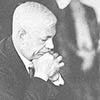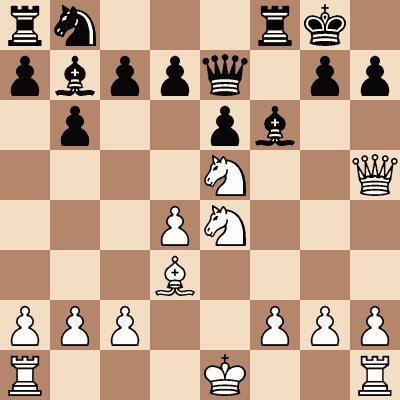Edward Lasker vs. George Alan Thomas
Edward Lasker vs. sir George Alan Thomas, London, 1912. White to move and win in 7! In the real confrontation the mate comes after the 8th, spectacular, move.
Roll over to see the solution: 1. Qxh7+ Kxh7 2. Nxf6+ Kh6 3. Neg4+ Kg5 4. f4+ Kh4 5. g3+ Kh3 6. Bf1+ Bg2 7. Nf2# or 1. Qxh7+ Kxh7 2. Nxf6+ Kh6 3. Neg4+ Kg5 4. h4+ Kf4 5. g3+ Kf3 6. Be2+ Kg2 7. Rh2+ Kg1 8. O-O-O#
FEN: rn3rk1/pbppq1pp/1p2pb2/4N2Q/3PN3/3B4/PPP2PPP/R3K2R w KQ - 7 11
About the players
 Edward Lasker (1885-1981), an engineer by profession, was a German-American chess and Go player. He was distantly related to the World Chess Champion Emanuel Lasker (1868-1941).
Edward Lasker (1885-1981), an engineer by profession, was a German-American chess and Go player. He was distantly related to the World Chess Champion Emanuel Lasker (1868-1941).  Sir George Alan Thomas (1881-1972), 7th Baronet. British badminton, tennis and chess player. He won the British Chess Championship twice.
Sir George Alan Thomas (1881-1972), 7th Baronet. British badminton, tennis and chess player. He won the British Chess Championship twice. 
I solved this puzzle in 7 moves : Qh5xh7+ Kg8xh7
2. Ne4xf6+ Kh7-h6
3. Ne5-g4+ Kh6-g5
4. f2-f4+ Kg5-h4
5. g2-g3+ Kh4-h3
6. Bd3-f1+ Bb7-g2
7. Ng4-f2#
slecht vertalen doet het hierzo,,,nog eens een gemiste kans,,,dus nu weet ik het ECHT ZEKER,,,,,IK KOOP HET DUS NIET!!!!!!!!!!
afz;jsr vermeulen uit Denhaag.
I found two move win, Qf7 KingH8 Ng6
1. Qxh7+ Kxh7
2. Nxf6+ Kh6
3. Neg4+ Kg5
4. h4+ Kf4
5. g3+ Kf3
6. Be4
i have a rather… idiotic solution
1. Ne5-g6 h7xg6
2. Qh5xg6 Bf6xd4
3. c2-c3 Bd4-c5
4. f2-f3 Bc5-e3
5. h2-h4 Nb8-c6
6. Ne4-g5 Be3xg5
7. h4xg5 Rf8-f5
8. g2-g4 Rf5-e5+
9. Ke1-f2 Qe7-c5+
10. Kf2-g3 Re5xg5
11. Rh1-h8+ Kg8xh8
12. Qg6-h7#
1. Qxh7+ Kxh7
2. Nxf6+ Kh6
3. Neg4+ Kg5
4. f4+ Kh4
5. g3+ Kh3
6. Be2+Kg2
7. Rh2+ Kg1
8. O-O-O#
1. Qxh7+ – Kxh7
2. Nxf6++ – Kh6
3. Ng4+. – Kg5
4. h4+. – Kf4
5. f3#
GREAT COMBINATION
1. Wf2-f4—Bf6-f4+
2. g2-g3—Qe7-b4+
3. Ke1-e2—d7-d6
4. Ne4-g5—Bd7-f3+
5. Ke2xf3—Kg8-h8
7. Ng5-f7#
1. White f2-f4—Blackf6-h4+ The Right One …
2. g2-g3—Qe7-b4+
3. Ke1-e2—d7-d6
4. Ne4-g5—Bd7-f3+
5. Ke2xf3—Rf8-c8
6. Bd3xh7+—Kg8-h8
7. Ng5-f7#
Because of the number of moves, this puzzle is generally thought of and categorized as ‘difficult.’ Actually, it was easy… just look for the moves that give the opponent only one option.
I don’t see anyone discussing ne4 to f6. It’s a win in maximum of 3 moves
There are 4 scenarios:
1. Ne4 to f6 .. (qf6 or pf6 or kh8)
2. Qh7 mate
The 4th scenario is black rf6
2. Qh7 .. kg8
3. Qh8 mate
Please correct me if I’m wrong
Sorry kf8 not g8 in the last scenario
Yeah i see it now sorry
In scenario pf6 q takes q disadvantage for white
1.Qxh7 Kxh7 2.Nxf6 Kh6 (2…Kh8 3.Ng6 #)3.Neg4 Kg5 4.f4 Kh4 (4…Kxf4 5.g3 Kg5 6.h4#)5.g3 Kh3 6.Bf1 Bg2 7.Nf2#
1) Nxf6+ any move
2) Qxh7 mate
If 1….Rxf6
2. Qxh7+ Kf8
3. Qh8 mate
@David Hunter
1. Nxf6+ (any move)
2. Qxh7#
doesn’t work because of
1. Nxf6+ gxf6
2. Qxh7+ Qxh7
3. Bxh7+ Kxh7
and black is winning.
@Dwayne Burnett
@Parigyan Chakraborty
@Paumil Shah
These solutions are all correct. I believe in the game “18. Kd2#” instead of “18. 0-0-0#” was played. It’s a matter of preference what one considers more beautiful: mate by king move or mate by castling.
Another forced alternative solution, one move shorter, would be:
…
11. Qxh7+ Kxh7
12. Nxf6+ Kh6
13. Neg4+ Kg5
14. h4+ Kf4
15. g3+ Kf3
16. 0-0 (any move, e.g. Qxf6)
17. Nh2#
Paumil Shah no good, because after 6. Be2 (there’s no check), black B7x1h.
Qxh7+ – Kxh7
2. Nxf6++ – Kh6
3. Ng4+. – Kg5
4. h4+. – Kf4
5.g3+.Kf3
6.Be2+.Kg2
7.o-o-o.gxf2
8.rdg1#
*gxf6
Christian
February 8, 2022 at 03:11
@Dwayne Burnett
@Parigyan Chakraborty
@Paumil Shah
These solutions are all correct. I believe in the game “18. Kd2#” instead of “18. 0-0-0#” was played. It’s a matter of preference what one considers more beautiful: mate by king move or mate by castling.
Another forced alternative solution, one move shorter, would be:
…
11. Qxh7+ Kxh7
12. Nxf6+ Kh6
13. Neg4+ Kg5
14. h4+ Kf4
15. g3+ Kf3
16. 0-0 (any move, e.g. Qxf6)
17. Nh2#
I agree
I solved this puzzle in 7 moves : Qh5xh7+ Kg8xh7
2. Ne4xf6+ Kh7-h6
3. Ne5-g4+ Kh6-g5
4. f2-f4+ Kg5-h4
5. g2-g3+ Kh4-h3
6. Bd3-f1+ Bb7-g2
7. Ng4-f2#
What if in move 2 above, Kh7-kh8, I don’t see a mate after that.
If any move is g7xf6?